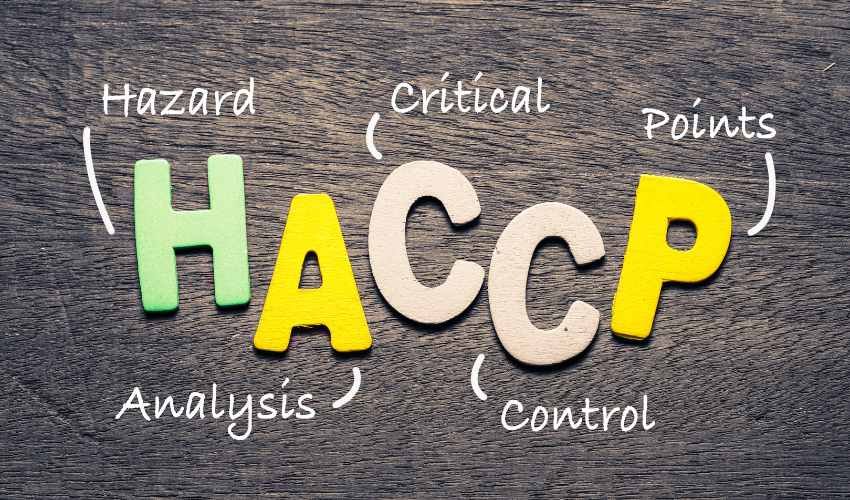
BLOG

What Is HACCP?
The food industry has long relied on effective safety practices to prevent contamination and ensure consumer well-being. One of the most recognized programs in food safety is HACCP.
HACCP stands for Hazard Analysis and Critical Control Points. Developed to tackle food safety hazards systematically, hazard analysis critical control points have become a global standard for identifying and controlling potential risks in food production processes. In this article, we’ll dive into HACCP meaning, and more.
What does HACCP stand for?
Hazard analysis critical control point is a preventive food safety approach that identifies, evaluates, and controls hazards to ensure the safety of food products. Initially developed in the 1960s for NASA’s space program, hazard critical control point has since evolved to become the foundation of food safety programs worldwide. So, what does HACCP stand for? The acronym HACCP stands for Hazard Analysis and Critical Control Point, and it serves as a systematic method to manage biological, chemical including radiological, and physical hazards and economically Motivated Food Safety Hazards throughout the food production and preparation processes.
What are HACCP 7 Principles?
It is based on HACCP 7 principles designed to prevent contamination and secure food safety. Understanding these principles is essential for developing an effective hazard analysis critical control point plan that ensures safety and compliance at every step.
Conduct a Hazard Analysis
Identify potential hazards that could affect food safety, including chemicals, radiological hazards, physical hazards, and economically Motivated Food Safety Hazards. This HACCP 7 principles emphasizes thoroughly examining all steps in the food production process to determine where these hazards are most likely to occur.
Determine Critical Control Points
Hazard Critical Control Points (CCPs) are stages in the production process where controls can be applied to prevent or reduce hazards to acceptable levels. Determining critical control points and their critical limits is crucial for managing food safety risks effectively.
Establish Critical Limits
For each CCP, set minimum or maximum limits (such as temperature, time, pressure, humidity, water activities, acidities, or pH levels) to ensure that the hazard is controlled. Critical limits are necessary for maintaining control over potential hazards.
Implement Monitoring Procedures
Establish procedures to monitor CCPs and ensure that critical limits are consistently met. Monitoring involves regular checks to confirm that safety measures are effective and maintained.
Establish Corrective Actions
When monitoring reveals a deviation from established limits, corrective actions must be in place. These actions are designed to fix the issue and prevent contaminated products from reaching consumers.
Establish Verification Procedures
Verification activities ensure that the Hazard analysis critical control pointi system works as intended. Verification can include regular reviews, testing, and validation procedures to confirm that all safety protocols are effective.
Record-Keeping and Documentation
Documentation is essential for tracking and validating the effectiveness of the hazard analysis critical control point plan. Records should include details of hazard analyses, CCPs, monitoring, corrective actions, verification and validation procedures. Proper documentation also helps with regulatory inspections and maintaining certification.
These HACCP 7 principles collectively form a robust framework for effectively managing potential hazards in the food production process.
Why is HACCP Certification Important?
Achieving hazard critical control point certification signifies that a business adheres to international food safety standards, including GFSI certification. Certification can improve consumer trust, enhance brand reputation, and facilitate compliance with legal and regulatory requirements.
For food producers and handlers, Hazard analysis critical control point certification is more than just a formality; it demonstrates a commitment to ensuring their food products are safe for consumption. Hazard Analysis and Critical Control Point certification is essential because it guarantees that a company has a system in place to keep food safe:
Enhanced Consumer Confidence
Certified companies can reassure consumers that they have implemented rigorous safety measures, which is increasingly important as people become more concerned about food safety.
Regulatory Compliance
Many countries require food businesses to follow HACCP 7 principles or similar food safety management systems. Certification helps ensure compliance with these requirements, reducing the risk of legal issues.
Market Access
Hazard critical control point-certified businesses often have an advantage when entering new markets, as certification is widely recognized internationally as a benchmark for food safety.
Operational Efficiency
A properly implemented HACCP plan can streamline production processes by identifying and addressing inefficiencies related to safety controls.
To obtain Hazard analysis critical control pointiscertification, a business must be audited by a third party to confirm that all necessary steps have been taken to ensure food safety.
How To Develop A HACCP Plan?
Creating a successful hazard analysis critical control point plan involves understanding each principle and applying it to specific processes. Here’s a step-by-step approach:
Assemble the HACCP Team
Form a team of individuals with diverse expertise in food safety, production, and quality assurance to develop and oversee the Hazard analysis critical control points plan.
Describe the Product
Document details of the product, including its composition, intended use, and target consumers.
Identify Intended Use and Consumers
Understand who will consume the product and how it’s likely to be used, as this impacts potential hazards.
Construct a Process Flow Diagram
Outline each step of the production process from receiving ingredients to final packaging.
Verify the Flow Diagram
Confirm the accuracy of the flow diagram by reviewing it on-site.
After these preparatory steps, apply the HACCP 7 principles to address any potential hazards identified in the process.
The Future of HACCP in Food Safety
As consumer awareness of food safety continues to grow, the Hazard Analysis Critical Control Point principles are more critical than ever. HACCP is also evolving to address new challenges, including allergen control, food fraud prevention, and the integration of digital monitoring tools. These advancements make it easier to maintain accurate records, monitor CCPs in real-time, and ensure rapid corrective actions when necessary.
Conclusion
In today’s food industry, HACCP is indispensable for managing risks and ensuring safe, high-quality food production. From understanding what HACCP stands for to implement the HACCP 7 principles, businesses must adopt this robust framework to meet both regulatory requirements and consumer expectations. With the proper certification, companies can enhance trust, improve safety, and unlock new market opportunities, positioning themselves as leaders in food safety compliance.

HACCP FAQs:
What does HACCP stand for, and why is it important?
HACCP stands for Hazard Analysis Critical Control Point. It’s important because it provides a systematic approach to identifying, evaluating, and controlling food safety hazards, ensuring safe food production and protecting consumers from foodborne illnesses.
What are the HACCP 7 principles?
The HACCP 7 principles are: (1) Conduct a hazard analysis, (2) Determine critical control points (CCPs), (3) Establish critical limits, (4) Implement monitoring procedures, (5) Establish corrective actions, (6) Verify the hazard analysis critical control point system, and (7) Record-keeping and documentation.
Who needs HACCP certification?
HACCP certification is beneficial for any business involved in food production, handling, processing, or distribution. This includes restaurants, manufacturers, processors, distributors, and suppliers who want to ensure food safety, gain consumer trust, and comply with regulatory requirements.
How do you create a HACCP plan?
Creating a HACCP plan involves assembling a Hazard analysis critical control point team, describing the product, identifying intended use, constructing and verifying a process flow diagram, and then applying the 7 principles of hazard critical control point to control and monitor identified hazards.
What’s the difference between a hazard and a critical control point (CCP)?
A hazard is any potential source of contamination or harm that could affect food safety (biological, chemical, or physical). A Hazard Critical Control Point (CCP) is a step in the production process where control measures can be applied to prevent, eliminate, or reduce the hazard to a safe level.
